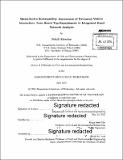| dc.contributor.advisor | Franz-Josef Ulm. | en_US |
| dc.contributor.author | Akbarian, Mehdi | en_US |
| dc.contributor.other | Massachusetts Institute of Technology. Department of Civil and Environmental Engineering. | en_US |
| dc.coverage.spatial | n-us-ca | en_US |
| dc.date.accessioned | 2015-10-30T19:01:02Z | |
| dc.date.available | 2015-10-30T19:01:02Z | |
| dc.date.copyright | 2015 | en_US |
| dc.date.issued | 2015 | en_US |
| dc.identifier.uri | http://hdl.handle.net/1721.1/99616 | |
| dc.description | Thesis: Ph. D., Massachusetts Institute of Technology, Department of Civil and Environmental Engineering, 2015. | en_US |
| dc.description | Cataloged from PDF version of thesis. | en_US |
| dc.description | Includes bibliographical references (pages 180-192). | en_US |
| dc.description.abstract | The sustainable development of our nation's roadway system requires quantitative means to link infrastructure performance to lifecycle energy use and greenhouse gas (GHG) emissions. Beside surface texture and roughness-induced Pavement-Vehicle Interactions (PVI), we herein recognize that the dissipation of mechanical work provided by the vehicle due to viscous deformation within the pavement structure is a relevant factor contributing to the environmental footprint of pavements. Through a combination of dimensional analysis, experiments and model-based simulations of energy dissipation in pavement structures, the key drivers of deflection-induced PVI are identified. Specifically, a novel experimental setup is developed to study the mechanism of deflection-induced PVI on small-scale silicone elastomer representations of two layered pavement systems, through visual observations of the pavement response and measurements of the dissipated energy. It is shown that the energy which is dissipated when a load moves at a constant speed along a pavement can be reduced to a dimensionless form that scales with the square of the vehicle load, the inverse of the vehicle speed, and relevant elastic and viscoelastic material and structural properties. These experimental findings form the basis for model development in which the pavement is represented as a viscoelastic beam on elastic foundation in a moving coordinate system. Using the experimentally identified dimensionless form of the model, the dimensionless energy dissipation is calibrated against actual pavement materials (concrete and asphalt) considering the specific temperature dependence of the viscoelastic deformation rate of these materials. For engineering applications, the analytical model is employed to calibrate the dimensionless dissipation in function of two material and speed-specific invariants representative of the range of values relevant for pavement engineering and road network analysis. We demonstrate that the derived model -when implemented at a network scale - provides a powerful basis for big data analytics of excess-energy consumption and GHG emission by integrating spatially and temporally varying road conditions, pavement structures, traffic loads and climatic conditions. Implemented for 50,000 lane-miles of the interstate highway system of the State of California, we demonstrate that a ranking based on the inferred GHG-emissions exhibits a power-law data distribution, akin to Zipf's Law, which provides a means to map an optimum path for GHG savings per retrofit at network scale. | en_US |
| dc.description.statementofresponsibility | by Mehdi Akbarian. | en_US |
| dc.format.extent | 195 pages | en_US |
| dc.language.iso | eng | en_US |
| dc.publisher | Massachusetts Institute of Technology | en_US |
| dc.rights | M.I.T. theses are protected by copyright. They may be viewed from this source for any purpose, but reproduction or distribution in any format is prohibited without written permission. See provided URL for inquiries about permission. | en_US |
| dc.rights.uri | http://dspace.mit.edu/handle/1721.1/7582 | en_US |
| dc.subject | Civil and Environmental Engineering. | en_US |
| dc.title | Quantitative sustainability assessment of pavement-vehicle interaction : from bench-top experiments to integrated road network analysis | en_US |
| dc.type | Thesis | en_US |
| dc.description.degree | Ph. D. | en_US |
| dc.contributor.department | Massachusetts Institute of Technology. Department of Civil and Environmental Engineering | |
| dc.identifier.oclc | 925538305 | en_US |
